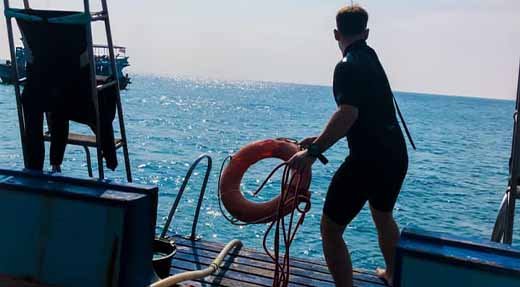PADI Rescue Diver
Wanna be Rescue ready?
While being a scuba diver is cool telling someone you are a rescue diver evokes the image of some sort of scuba diving Baywatch type character coming to help people in trouble. While the PADI Rescue Diver course may not exactly involve sprinting up and down the beach sporting red shorts or a bikini, you will be taking part in one of the most challenging and rewarding courses within the PADI system when you decide to become a rescue diver.
The subject is serious, but the training is fun!
Changing Your Focus
Rescue Diver training increases awareness of the dive environment and shifts your focus from yourself to your surroundings and dive buddies. Learning how to interpret and react to those factors makes the course both fulfilling and fun. Gaining the knowledge to prevent and manage problems in the water will enhance confidence in your diving skills. You will know you can help other divers if needed.
Essential Life Skills
To be able to participate in the Rescue course you need to hold an up-to-date first aid primary and secondary care certificate. The emergency skills you learn in this course can be important in day-to-day life not just when near the water. Learning essential lifesaving skills such as C.P.R. may come to good use one day in saving someone from death or possibly long-term disability.
You will also be taught secondary care techniques so you can help people you have the misfortune to have had a cut, break or dislocation get back on the road to recovery.
Above The Below
Unlike previous scuba diving courses, you have completed the PADI Rescue Diver course does not include a large amount of time underwater. It is broken up into 2 main sections, the first of which is theory. You will study topics including the psychology of rescue, recognizing diver stress and preparing an emergency assistance plan for a specific dive site.
The Emergency Assistance plan is designed as a guideline to follow in case an accident was to happen and will help you to take the right steps in dealing with the situation on a given dive site. You will also study more in-depth physiology.
The second section of the course is focused on introducing and mastering new rescue-specific water skills. This involves a lot of teamwork and role-play and demands constant awareness and quick thinking. The primary course focus is on preventing accidents from happening in the first place. It is always preferable to avert an emergency rather than to face one.
Stop and Think
One of the key skills in becoming a rescue diver is to always put yourself first, anytime an emergency occurs you must always stop and think first.
Do I need to enter the water?
Do I have the correct equipment?
Can I ensure my own safety to conduct the rescue?
Everyone wants to be a hero but no one wants to become a casualty themselves, it’s a fine balance that you will learn during the rescue exercises. You will learn for example that you should not be running around and charging into the water without the correct equipment when it could have been a lot simpler to throw a floatation device to a potential victim.
Train Hard, Dive Easy
There are ten rescue exercises to master. These skills teach you how to react to a variety of potential accidents or scenarios. These include learning how to assist tired and panicked divers, responding to distressed divers from shore and underwater, using underwater search patterns to locate missing divers,
proper exiting techniques onto the shore and the boat and how to provide in-water rescue breaths.
Mastery of these skills could one day mean the difference between tragedy and survival. Expect to repeat the skills, and scenarios a number of times. After all, practice makes perfect. During the scenarios you will be expected to react in the correct manor and as if it was a real emergency, moving quickly and efficiently.
The Final Test
Before you can be certified as a Rescue Diver you need to successful complete two final scenarios. These are designed to put everything you have learnt over the previous few days into practice.
You will be required to react to an unresponsive diver at the surface and an unresponsive diver underwater, performing the necessary steps for a rescue from start to finish.
The aim is, in a timely manner, safely and by using the correct techniques to bring the unconscious diver back to either shore or land.
While the instructor does understand there is no such thing as a perfect rescue in real life they will want to see you doing things as correctly as possible.
Stepping Stone
The skills you learn and the confidence you gain whilst completing the course will prepare you for taking on further challenges and moving on to becoming a PADI Master Scuba Diver or a Divemaster.
You may also become interested in taking the Emergency Oxygen Provider course which goes hand in hand with being a rescue diver so you can safely administrate 100% pure oxygen to an injured diver.
© Crystal Dive Koh Tao





